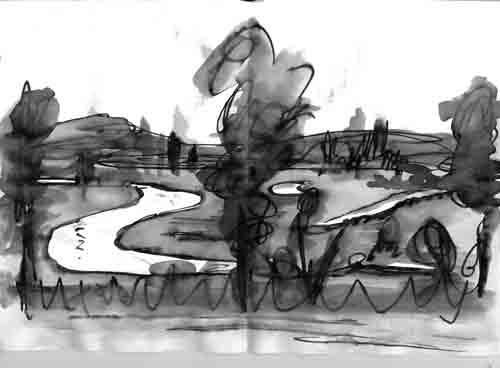The Lyme Maze Game

|
There is another way to get to Lyme, without driving. Go to Waterloo station and buy a train ticket. You're directed to Platform Seven (or it may be Nine or Fourteen), where waits the train that goes all the way to Exeter — Axminster is one of the later stops on the way. All the Southwest company's trains are painted in swooping patterns of three colours — red, yellow, blue — that put you in a good mood. Hurry to one of the front three coaches (you'll see why); grab a seat (preferably at a table — space to spread papers and your legs) with a forward view. On the right as the train moves out, catch sight of the London Eye soaring over the Thames, and Battersea Power Station with its four chimneys like simplified minarets of a Turkish mosque. Then tall tenements, some of rather graceful design; fairly fine graffiti (though London's are less colorful than New York's); Clapham Junction; Wimbledon; other Surrey suburbs; Hampshire countryside, which becomes gradually more pleasing. Salisbury Plain, a rolling upland (made of chalk, as you can see in the cuttings); and as you come into Salisbury watch on the left for the spire of the cathedral, England's tallest. Here some of the carriages are disconnected and only the front ones go on to the west country. And from here on the landscape becomes shapely on a smaller scale. From Salisbury up to Tisbury, there are glimpses of a little river: it is the Nadder, one of the five that meet in Salisbury's water-meadows to form one of England's three rivers called by the old Celtic name Avon. Just before Tisbury the train may wait ten minutes in a siding for its colleague from the opposite direction to pass. Only parts of the rail route are two-track; Tisbury station was built wide enough for two tracks—but for only one platform, so that though two trains could stand there only one could serve passengers! Also, Tisbury platform is unusually short, so that alighters must be in the front two carriages. When you stop briefly there, blow a kiss for me to the Southwestern Inn down on the right, in front of the church: it was here that we found cheerful lodging after a day's bicycle ride (from Stonehenge); the window southwest of the "Southwest" sign was our window. After Tisbury you are climbing through a soft gap in the western rim of the chalk uplands of Salisbury Plain; this is the geographical gateway from south-central into southwestern England. The line emerges into a bowl of lowland that is the Vale of Blackmoor (or Blackmore) in northern Dorset, known to readers of Thomas Hardy; for instance Tess of the D'Urbervilles came from one of its villages, Marnhull (Hardy's "Marlott", in the "Vale of Blakemore"). You stop at Gillingham in this plain; leave the plain through a tunnel. At Temple Combe station there is a statue curiously facing away (I haven't yet set foot there to find the story). Then Sherborne, in the northern fringe of Dorset; as the train slows toward it, look out on the left for the older of two castles. Yeovil, spreading city near the southern border of the Somerset Levels (you can see the chalk scarps away to the left); then Crewkerne in its knot of hills; and after Crewkerne you begin to notice the coils of another river, mainly to the left of the train, though often dodging to the right like a porpoise playing around a straight-moving ship. From a train, as from a plane, the most reliably beautiful features of a landscape are its rivers.
A river uses meanders as a carpenter uses a plane: by pushing meander after meander downstream it cuts its flat-floored valley. This river is the Axe, and its long smooth valley, slanting southwest through the spine of the peninsula, is the avenue along which ran the ancient Fosse Way, from Lincoln and the Midlands to the sea at Axmouth. The railway, however, does not follow the valley all the way to the sea; the nearest it reaches, before bending away inland, is at Axminster. Here, after a journey of nearly three hours, the train makes one of its brief halts. Somewhere along the ride, an official should have come along the gangway inspecting tickets. Strangely, he asks: "Which century are you in?" "I beg your pardon?" "Is your ticket stamped for 1907 or 2007?" "Well!" you reply, "2007, of course!" Or, "1907, of course." And he punches your ticket. With the result that when you get out at Axminster— |
